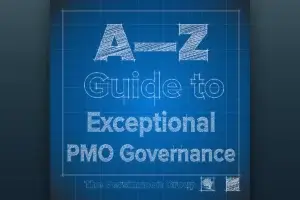Strategic decision-making in portfolio management demands diverse perspectives—the Six Thinking Hats offer PMO leaders a structured framework to overcome cognitive biases and drive more effective organizational outcomes.
How Do You Make Decisions?
What is your natural approach to decision-making? Do you have an instinctive “feel” for what should be done? Or do you take ample time to analyze data and understand the problem before making a move?
Likely, you have a default style that feels comfortable to you. For many of us, that default style is so comfortable that we undervalue alternative ways to make decisions. We may even unwittingly hire people only with similar styles, so that our teams develop a kind of decision-making personality of its own.
However, research on team decision-making suggests that cognitively diverse groups make better decisions.Katherine Phillips’ groundbreaking research at Columbia Business School demonstrated that diverse teams outperform homogeneous ones specifically because they process information more thoroughly and consider multiple perspectives—abilities that are crucial for PMOs managing complex portfolio decisions. This often requires leadership teams to think in ways that challenge their established patterns.
This is the premise of one of our favorite books on group decision making—The Six Thinking Hats by Edward de Bono. In easy, approachable language, de Bono walks us through six thinking processes or “hats.”
All of us are capable of thinking in all six ways, but most of us have one or two hats that we are most comfortable wearing. De Bono recommends that whenever we need to make an important decision, we do two critical things:
- Invite people into the discussion who represent a cross-section of these instinctive ways of thinking
- Structure your discussion so that ALL participants collectively consider the problem of wearing all six “hats.”
We’ve found that for our clients, understanding and implementing the concept of six thinking hats has led to more effective prioritization decisions, stronger project teams, and a sounder overall approach to setting and adapting strategy.
The Six Thinking Hats And How To Use Them
The Thinking Hats represent six unique styles of decision-making: facts, feelings, control, creativity, positive and negative. All six are critical to well-rounded decision-making while lacking diversity can lead to destructive blind spots.
Once you understand the six decision styles, they can be used in three significant ways:
- Decision-Making Framework. A methodical hat-by-hat analysis of a decision ensures that all perspectives are considered, even if you don’t have all six styles represented in the room. This reduces risk even as you increase potential for innovation.
- Diversity Check. Teams can use the hats to ensure that the right mix of people are in the room given the particular type of meeting, problem, or situation at hand.
- Team Cohesion. When one “hat” is in the minority, it can be easy for them to feel disengaged and discounted by others. The six thinking hats creates an environment of both mutual understanding and direct engagement with opposing viewpoints.
Let’s explore each of these six thinking styles in detail, examining how PMO leaders can leverage them to transform strategic decision-making.
Green Hat: The Innovator
Green-hat thinking sparks creativity and fresh ideas. These thinkers love to explore “what if” scenarios and push boundaries. They shine when teams need breakthrough solutions and get energized by challenging conventional approaches. In strategy meetings, they’re the ones asking, “Why not try something completely different?” and helping teams see beyond the usual playbook.
They Help:
- Break through mental barriers when teams are stuck in old patterns
- Spot game-changing opportunities others might miss
- Challenge assumptions about what’s possible or “the way we’ve always done it.”
When Overused, They Can:
- Create idea overload that leads to decision paralysis
- Propose exciting but impractical solutions disconnected from reality
- Push for constant reinvention that prevents executing any strategy effectively
Red Hat: The Intuitive
Red-hat thinking taps into gut feelings and emotional intelligence. These thinkers trust their instincts and can read the room brilliantly. They excel at spotting when seemingly logical plans might face human resistance and can predict how changes will make people feel. They’re often right even when they can’t immediately explain why.
They Help:
- Provide rapid assessments of situations based on experience and intuition
- Detect early warning signals about how stakeholders will respond emotionally
- Identify unspoken concerns that data and analysis might miss
When Overused, They Can:
- Make decisions based on feelings while ignoring important evidence
- Struggle to articulate clear rationales that others can understand
- Dismiss valid data that contradicts their gut feelings
Blue Hat: The Orchestrator
Blue-hat thinking brings order to decision chaos. These thinkers love creating clarity and structure. They excel at guiding teams through complex decisions step by step and turning big ideas into actionable plans. They often ask, “What exactly are we deciding today?” and “Who’s doing what by when?”
They Help:
- Establish clear processes that ensure all perspectives get fair consideration
- Synthesize different viewpoints into actionable decisions
- Drive follow-through that turns discussions into real-world results
When Overused, They Can:
- Push for premature decisions due to their action orientation
- Resist innovation that adds time to the decision-making process
- Focus so much on processes that the substance gets lost
Black Hat: The Risk Assessor
Black-hat thinking spots potential problems before they happen. These thinkers have a talent for identifying what could go wrong and challenging rosy assumptions. They strengthen plans by finding the weak spots first and asking the tough questions others might avoid. They’re often heard saying, “Have we considered what happens if…”
They Help:
- Identify critical risks that could derail initiatives before they happen
- Offer constructive criticism that strengthens plans before implementation
- Provide reality checks that prevent overly optimistic forecasting
When Overused, They Can:
- Create excessive caution that prevents necessary risk-taking
- Focus so much on what could go wrong that opportunities are missed
- Spread pessimism that dampens team motivation and energy
Yellow Hat: The Opportunity Seeker
Yellow-hat thinking finds the upside in every situation. These thinkers naturally spot potential benefits and possibilities. They excel at building enthusiasm for new initiatives and keeping teams motivated during challenging times. They’re the ones saying “Here’s why this could be huge for us” and “Let’s not lose sight of the opportunity here.”
They Help:
- Envision potential benefits when others see only challenges
- Maintain momentum and energy when teams face difficult implementation
- Balance critical thinking by highlighting meaningful upsides
When Overused, They Can:
- Create unrealistic expectations about potential outcomes
- Underestimate genuine obstacles and legitimate concerns
- Support failing initiatives too long when data suggests pivoting
White Hat: The Data Analyst
White-hat thinking grounds decisions in facts and evidence. These thinkers cut through opinions with data and precise analysis. They excel at separating verified facts from assumptions and measuring what really happens versus what was predicted. They often ask, “What do we actually know for sure?” and “How will we measure success?”
They Help:
- Provide a factual foundation that cuts through opinion and speculation
- Establish clear metrics that allow objective measurement of success
- Offer historical context about what has and hasn’t worked before
When Overused, They Can:
- Wait for “perfect” data when timely decisions are needed
- Overemphasize measurable factors while missing qualitative insights
- Create analysis paralysis that prevents decisive action in uncertain situations
Implementing the Six Thinking Hats in Your PMO
Understanding these six perspectives is just the beginning. The real power emerges when you deliberately incorporate all six thinking styles into your PMO’s decision-making processes. Here are three practical ways to start:
- Assess Your Current Team: Take a moment to consider which thinking styles dominate your PMO and which might be underrepresented. Most teams naturally skew toward certain hats, while others remain “minority voices” that struggle to be heard. Creating awareness of these patterns is the first step toward more balanced decisions.
- Structure Critical Meetings: For high-stakes portfolio decisions, explicitly allocate time for each thinking style. Try statements like “Let’s take five minutes for white hat analysis” or “Now I’d like everyone to put on their black hat and identify potential risks.” This structured approach ensures all perspectives receive equal consideration.
- Embrace Productive Tension: When different thinking styles clash—like when your detail-oriented data analyst challenges your intuitive stakeholder—recognize this tension as valuable rather than problematic. These moments of productive disagreement often lead to your most well-rounded decisions.
The Six Thinking Hats framework doesn’t just improve individual decisions—it can transform your PMO’s decision-making culture. When teams understand and respect different cognitive approaches, they build stronger working relationships and develop more resilient strategies. Portfolio management becomes less about avoiding mistakes and more about making comprehensively considered choices with a clear-eyed awareness of both opportunities and risks.
Interested in implementing this with your PMO team? Download this “cheat sheet” and distribute it to your teams to guide portfolio discussions!









